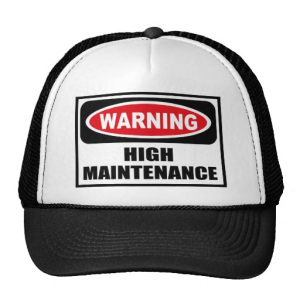 Any organization, department, division or office that experiences a high turnover of employees in a short period of time definitely has issues that go deeper than just the employee that went through the revolving door. Unfortunately, numerous offices experience this – yet never look at the root cause of why it’s happening. Whether you know it or not, the ‘revolving door syndrome’ has a detrimental impact on others nearby, costs the organization money, and might just be the ‘beginning of the end’ for many organizations. Too often, managers link high turnover to people who are not dedicated, lack talent, or are just incompetent to do the job. However, I’ve learned through my experiences…and it’s also proven through academic research…that a significant part of the problem is not with the people, it’s with the system that’s been created in which they work. So, what could be wrong with the system or the process? Well – many things. My next few blog posts will highlight some of those areas.
Any organization, department, division or office that experiences a high turnover of employees in a short period of time definitely has issues that go deeper than just the employee that went through the revolving door. Unfortunately, numerous offices experience this – yet never look at the root cause of why it’s happening. Whether you know it or not, the ‘revolving door syndrome’ has a detrimental impact on others nearby, costs the organization money, and might just be the ‘beginning of the end’ for many organizations. Too often, managers link high turnover to people who are not dedicated, lack talent, or are just incompetent to do the job. However, I’ve learned through my experiences…and it’s also proven through academic research…that a significant part of the problem is not with the people, it’s with the system that’s been created in which they work. So, what could be wrong with the system or the process? Well – many things. My next few blog posts will highlight some of those areas.
One such issue that could be throwing the system in a tilt is the management style – specifically micromanagement. There seems to be a very fine line between macro-managing and micro-managing. Most of us would say we are macro-managers and we allow our employees some space in order to carry out the responsibilities of their job. But sadly, there are too many managers who think they are doing a bang-up job and supporting their employees, when actually…they are doing just the opposite and hand-cuffing the very people who are there to help. So,are you a micro-manager? Let’s look at some of the signs:
- Do you resist delegating work to others?
- Do you focus on ‘overseeing’ the projects of others?
- If you find mistakes, do you tend to take the project back in order to complete it yourself?
- Do you focus on the small details and tasks instead of the big picture?
- Do you ask others to ‘consult’ you before they make a decision?
If you answered ‘yes’ to any of the above questions, then you may be headed into the vast land of micro-management. But, you may be asking, “What’s wrong with micro-managing if it delivers the results I want?” Good question. My view on it is this…micro-managers tend to take certain attributes to the extreme. When this occurs, then there develops an obsession to control everything – even to the point of rendering their colleagues powerless. Then you run the risk of ruining their self-confidence, causing them to quit, and/or damaging their performance itself. You may achieve the original goal you intended, but at what cost? So take a strong inventory of your management style and find a healthy balance that helps to empower others around you to develop, grow, and make the necessary decisions to move the organization forward.
Photo Credit
Tags: customer service, efficiency, employee performance, encouragement, leadership, management skills, management styles, manager performance, organizational performance, skills, trust, workplace training
 Most every school has something they call the ‘honor roll’ and it’s always a distinguished recognition of those students who are doing things right and are successful in the classroom. But when we move from the halls of academia and into the world of business, it becomes more and more challenging to know when you are ‘doing things right.’ It’s my opinion that even in the business environment, one’s honor can still be utilized as a measurement tool of a managers effectiveness and overall success within the workplace.
Most every school has something they call the ‘honor roll’ and it’s always a distinguished recognition of those students who are doing things right and are successful in the classroom. But when we move from the halls of academia and into the world of business, it becomes more and more challenging to know when you are ‘doing things right.’ It’s my opinion that even in the business environment, one’s honor can still be utilized as a measurement tool of a managers effectiveness and overall success within the workplace.
In today’s organizations, it’s easy for managers to feel compelled to ‘adapt’ or be everything to everyone. But being a person of excellence – one of respect, means you must strike a careful balance in all your actions and decisions in order to maintain your honor in the eyes of others. We’ve all heard the horror stories of those bad bosses that basically take advantage of every opportunity – both ethical and unethical ones – just to get ahead and benefit only themselves. It’s those scenarios that play out in the minds of workers that create a tension sometimes between various levels in the workplace, i.e. upper management and other workers. Therefore, to correct or improve upon that stereotypical mindset…it’s vital that today’s managers display honor in the workplace. How can one maintain his or her honor and still be an effective manager? Here are five suggestions to consider:
- Be honest – It’s critical to be honest with your employees whenever they ask direct questions…or even indirect questions. If you try to lie or exaggerate truths, then you will be found out and your image of honor will be damaged beyond repair. Always be tactful, but truthful.
- Trust others – Give others a chance to develop that trusting relationship. The more you trust others, then the more others will view you as being trustworthy. Be sure to develop a strong bond with your workforce and always-always-always keep your word.
- Protect your space – Don’t feel like you have to be a ‘part of the crowd’ just to be liked or honored by the workforce. It’s easy to be lured into doing things that everyone else is doing. So be mindful of what is ‘appropriate’ behavior, then guard your personal space to maintain and display that behavior.
- Operate on facts – Identify and call out others (if you have to) that are spreading rumors, gossip or any information that can’t be proven or substantiated. Sending a strong message that you’re only interested in facts will show others that you don’t want to participate in the ‘water cooler conversations’.
- Know the difference – Be able to distinguish between an honorable act and a dishonorable act. If it doesn’t sound right, feel right or look right…then more than likely it’s a dishonorable action. So, be cautious and think before you act or before you speak. Not knowing the difference is probably the quickest way to be out of a job.
These are just a few suggestions to help you in establishing and/or maintaining your honor in the workplace. Take time this week to practice these and other ideas and see what type of response you get from others. Have a great day!!
Photo Credit
Tags: community issues, customer service, economic development, efficiency, employee performance, encouragement, leadership, management skills, management styles, manager performance, organizational performance, perception, skills, trust, workforce, workplace training
 All of us have at least one thing we fear. Some fear death and some fear spiders, while others may have the fear of heights or the fear of failing. In a managerial position, the same concept is true. Managers have fears about competition, meeting deadlines, quarterly earnings, etc. So, how can we best overcome our fears? Well, one of my good friends had a fear of riding roller coasters; however, one day he calls me up and says, ‘hey, let’s go to Six Flags.’ Of course, I reminded him that he didn’t like roller coasters, but he was adamant to go and conquer his fear. He had looked up information online about roller coasters and he had watched simulation videos of roller coaster rides. So, he was equipped and prepared to meet his fear head-on.
All of us have at least one thing we fear. Some fear death and some fear spiders, while others may have the fear of heights or the fear of failing. In a managerial position, the same concept is true. Managers have fears about competition, meeting deadlines, quarterly earnings, etc. So, how can we best overcome our fears? Well, one of my good friends had a fear of riding roller coasters; however, one day he calls me up and says, ‘hey, let’s go to Six Flags.’ Of course, I reminded him that he didn’t like roller coasters, but he was adamant to go and conquer his fear. He had looked up information online about roller coasters and he had watched simulation videos of roller coaster rides. So, he was equipped and prepared to meet his fear head-on.
Therefore, the best way for managers to conquer their fears in the workplace is to change the way they think about fear. This can be done by simply equipping and preparing themselves for a direct encounter with each fear. This basically means doing just two things:
- Turn Your Fears into Fascination Drivers – In other words, research and learn as much as you can about each fear. What can you learn from it and how can you turn it into a source of positive energy? If you have a fear about your competition, then learn everything you can about them. What makes them tick? What are their goals? In what areas are they strong and weak? Then, take this information and determine how you can re-frame it into a positive aspect that will be beneficial for you and your team.
- View Your Fears as Opportunities – Start looking at fear as an indicator of something that needs attention…and not as something to avoid. It’s a way to identify problems and issues and then to develop strategies to overcome those problems and issues. Have a fear about an upcoming deadline, then take charge and develop a plan in advance with specific timelines for each step that’s needed in meeting your deadline. Don’t procrastinate just because you have a fear because when you do that, then you’re allowing the fear to take control of your management process.
By becoming fascinated with your managerial fears and learning how to turn them into opportunities, you can become more effective in your day to day responsibilities and push forward into new, innovative areas that will advance the overall mission of your organization. So this week, take time to list a few of your immediate fears and start changing how you think about each particular one.
Photo Credit
Tags: coaching, customer service, efficiency, employee performance, encouragement, leadership, management skills, management styles, manager, organizational performance, skills, time management, trust, workplace training

(Repost of ‘Your Word, Your Brand’ of April 5, 2013)
Most of us have certain defining moments in our lives that make us stop to ponder that age-old question, “Why do I do what I do?” Whether you’re at the helm of a large corporation with thousands of employees or you sack groceries at the local neighborhood supermarket…we all have various reasons for the paths we take in life and at times it is important to reflect on the choices we make. One of those defining moments for me was standing in my office on the morning of September 11, 2001 and watching the events unfold on television regarding the terrorist attacks in New York City and the countless lives that were lost that day. On that day, it was no longer about meeting a print deadline or making sure enough ink pens were ordered or even making sure I got my car payment in the mail on time…it was all about ‘what am I doing to make a difference in the lives of others?’ That internal question defined a whole new way of thinking for me and changed the course of how I managed others.
For me, I quickly realized that there were no policies and procedures, no personnel manuals, no workplace training and no professional management courses that can replace your spoken “word”. I would even go as far to say that the days of cutting a business deal with a simple smile and a handshake were back – for me, at least. And looking back at that internal question of how am I making a difference, I knew that when I take away all of the glitz and glamor…my “word” was the most valuable tool I had to make a true difference.
As managers, it is so easy to get caught up in the day-to-day routine of business operations that we tend to forget that what we say and do affect many others around us – individual workers, multiple families, whole communities. It’s easy to get riled up and ticked off at upper management or your colleagues or your customers (yes, even your customers can tick you off); but if you want to make a true difference – don’t let those things steal your joy or your passion for doing what you do because your word IS your brand. When it comes right down to it…your ‘word’ – who you say you are – is all you have when you really want to impact and encourage your employees or when you are negotiating a business deal to bring jobs and revenue to your local community or when you’re trying to motivate others toward a common goal.
I experienced another one of those defining moments just a few months ago with the tragic loss of my 22 year old nephew. Realizing how we all have such a brief window of opportunity to mark our spot in this world and to make a difference in the lives of others is an energizing and rejuvenating jolt that should bring us all back to the core of why we do, what we do. There’s a quote by an anonymous writer that says, “You’re only as good as your word. Use them wisely, and stick by them. That’s capital worth investing in.” We all need to heed this saying and integrate its meaning into our lives.
So, I guess this blog post is geared toward encouraging you to do your very best in keeping your integrity in check and being true to who you say you are – so you can truly make a difference in the lives of those who cross your path – whether it be your employees, co-workers, friends or even family members. How you brand yourself speaks volumes to others. I challenge you to take some time this week and reflect on how you can make a difference and what you can be doing right now – today – to make that happen. Then, go mark your spot in this world!
Photo Credit
Tags: coaching, community issues, customer service, economic development, efficiency, employee performance, leadership, management skills, management styles, manager performance, organizational performance, perception, skills, time management, trust, workforce
 In Step #1, we looked at how we should use both quantitative and qualitative elements to best balance and measure time. Today, in Step #2, we consider how circumstances affect our perception of time. We’ve all heard the saying, “Time flies when you’re having fun.” Well, that’s not 100% scientifically accurate…BUT…there is some truth in it, especially related to our perception of time. According to the experts, time seems to move a little faster when we are enjoying ourselves and are more focused on the details of our work; however, that same time seems to slow down considerably when we are anxious, unhappy or anticipating something. For example, spending a great afternoon at the beach seems to go by so quickly for me because I am enjoying the scenery and relaxing…but if I am waiting for a call back from the doctor with results of a medical test, then it seems time just stands still.
In Step #1, we looked at how we should use both quantitative and qualitative elements to best balance and measure time. Today, in Step #2, we consider how circumstances affect our perception of time. We’ve all heard the saying, “Time flies when you’re having fun.” Well, that’s not 100% scientifically accurate…BUT…there is some truth in it, especially related to our perception of time. According to the experts, time seems to move a little faster when we are enjoying ourselves and are more focused on the details of our work; however, that same time seems to slow down considerably when we are anxious, unhappy or anticipating something. For example, spending a great afternoon at the beach seems to go by so quickly for me because I am enjoying the scenery and relaxing…but if I am waiting for a call back from the doctor with results of a medical test, then it seems time just stands still.
Marney Makridakis explains in her book about Creating Time, that “time moves faster when something else supersedes our inherent attention to time.” Therefore, for me – when I am more focused on relaxing and enjoying a vacation, time tends to move super fast…or when I am up against a hard deadline and I am so focused on the details of getting things completed, time slips away very quickly. So – how can we better manage these circumstances that affect our perception of time? It’s not easy. It may help to begin by simply making a list of those circumstances in the past where it seems time moved quickly for you…and a list of those events when time moved very slow. This will help you to better understand those moments and/or events that allow you to be more relaxed or focused, versus those times that you are overly anxious or full of anticipation. Then maybe you can take steps to grasp how you are viewing the use of your time each and every day.
Personally for me, when I take a road trip of any significant distance, it always seems that the travel time to get there is much longer than the travel time to return. This is because I am in a state of heightened anticipation when I am going, more-so than when I am returning. So, I look for things that will relax me or keep me focused – like listen to music or mentally plan out work items – so the drive doesn’t seem so long. Make your lists and consider those circumstances that impact your perception of time – then adjust it as you wish.
Photo Credit
Tags: deadlines, efficiency, employee performance, leadership, management skills, manager, organizational performance, perception, skills, time management
 In most organizations today, customer satisfaction is a critical performance measure regardless of what type of product or service you provide to the consumer. Even government-funded services (which are usually free to the consumer) weigh customer satisfaction very heavily when measuring performance. The one key factor in increasing the customer satisfaction rate is customer service. That’s why we have seen a significant increase in customer service trainings within businesses and organizations over the past decade.
In most organizations today, customer satisfaction is a critical performance measure regardless of what type of product or service you provide to the consumer. Even government-funded services (which are usually free to the consumer) weigh customer satisfaction very heavily when measuring performance. The one key factor in increasing the customer satisfaction rate is customer service. That’s why we have seen a significant increase in customer service trainings within businesses and organizations over the past decade.
Over the years, I have seen my fair share of good and bad customer service…and I am certain you have, also. From the drive-up window at your favorite fast food spot to the service counter at the post office, there’s certainly a varying level of customer service. Here are a few simple elements that your customers want to see:
- Professional Appearance – Seems simple, right? But you would be surprised how many times you go into a business and the first person you see looks like they’ve been hit by a truck. Being dressed professionally and having a clutter-free work space will speak volumes to your customer that you care about yourself. Think about it…if you don’t care about yourself, do you really think the customers feel that you care about them? One single item that can improve your professional appearance – a smile.
- Acknowledgement – Let the customer know you recognize they are present and then listen to their request. After all, they ARE your customer, right? Greet them appropriately by name (if you know it) and then inquire on how you can be of service to them. A simple acknowledgement goes a LONG way.
- Quick Response – Take action immediately on the customer’s request. If it will take a while to provide a final product or service, then at least keep the customer updated on the progress of their request. One of your goals should be to reduce wait time or eliminate it all together…because in today’s fast-paced world, no one likes to wait.
- Follow-up – Be sure the customer received the service/product they requested. Whether it be through a customer-satisfaction survey, a thank you note, or a quick question before they exit your business – always make certain that you inquire about the service that was provided. This step will greatly increase your chances of a repeat visit from the customer (that is, if their experience was a good one).
Just applying these four simple steps as you deal with customers will increase your customer satisfaction levels. Even if the customers don’t get exactly what they requested, the process of being professional, acknowledging them, responding and following up should create a satisfactory experience for all involved. Take time this week to implement these elements and see how your customers respond.
Photo Credit
Tags: customer service, efficiency, employee performance, honest, integrity, leadership, management skills, management styles, manager performance, organizational performance, perception, skills, workplace training
 For the western hemisphere, time is watched in a very critical way. In our daily lives we have alarm clocks to get us up and going; we have time clocks to punch in and out of work; we have sleep timers on our televisions so it will turn off at a certain time; and we have notification ‘dings’ on our electronic calendars to remind us and keep us on schedule. Yet, even with all of this, many people have difficulty showing up on time and meeting deadlines. I work each and every day with about 75 engineers – and many of them don’t even know the concept of time or the meaning behind hard deadlines. But, I digress. For employees, it’s vital to be mindful of time and to meet set deadlines in order to be effective and productive in accomplishing the goals and objectives of their organization, department and/or team.
For the western hemisphere, time is watched in a very critical way. In our daily lives we have alarm clocks to get us up and going; we have time clocks to punch in and out of work; we have sleep timers on our televisions so it will turn off at a certain time; and we have notification ‘dings’ on our electronic calendars to remind us and keep us on schedule. Yet, even with all of this, many people have difficulty showing up on time and meeting deadlines. I work each and every day with about 75 engineers – and many of them don’t even know the concept of time or the meaning behind hard deadlines. But, I digress. For employees, it’s vital to be mindful of time and to meet set deadlines in order to be effective and productive in accomplishing the goals and objectives of their organization, department and/or team.
Here are a few steps that have helped me through the years to get all tasks completed on time so that deadlines are met and performance is enhanced:
- Be Clear about Expectations – It’s critical to understand exactly what is expected by the deadline…as well as, the deadline itself. Ask questions and clarify any vague instructions and re-affirm the deadline date and/or time.
- Plan Your Schedule in Reverse – Start with the deadline period and plan your activities in reverse – allowing able time to complete each activity. Develop specific milestones or benchmarks to identify timeframes within the process so you can measure your progress appropriately.
- Focus on Tasks and Actions – If you’re working with a large or complex project, then it’s important to breakdown larger tasks into smaller, more manageable tasks. Focus on completing each smaller task so that you don’t become overwhelmed with the larger project at hand. This will keep you on track and moving toward meeting the deadline.
- Build in Extra Time – One rule of thumb to remember – ‘It always takes longer to complete than you think.’ So, build in additional time to allow for those unintended obstacles and delays that will pop up along the way.
- Communicate with All Involved – Keep all team players updated on the progress of each step – especially if you are working with multiple individuals and/or locations. One element that will always prevent you from meeting a deadline on time is poor communication. Therefore, be very detailed and concise in keeping communication open with everyone involved.
Get in front of your projects and follow these steps closely, and you’ll develop better time mangement in meeting your deadlines on a regular basis. And remember, no project is too large or too small for these steps to be effective. Begin applying these steps this week to your various projects and you’ll be more secure and confident as you meet your project deadlines.
Photo Credit
Tags: customer service, deadlines, efficiency, employee performance, management skills, manager, manager performance, skills, time management, workplace training
 It’s stressful for everyone when we have to deal with difficult employees on the job. Whether they have a bad attitude, lack in experience or just don’t have the necessary skills to actually do the job…the manager must determine the best way to deal with the employee. Often times, it will be one of two things: either coach the individual to become a better employee, or let the employee go.
It’s stressful for everyone when we have to deal with difficult employees on the job. Whether they have a bad attitude, lack in experience or just don’t have the necessary skills to actually do the job…the manager must determine the best way to deal with the employee. Often times, it will be one of two things: either coach the individual to become a better employee, or let the employee go.
So, if you’re dealing with a difficult employee and don’t know what to do about it, then look at these steps to get an idea on how to proceed:
- Set Expectations with all employees when they are hired about what behaviors and actions are grounds for immediate termination. Also, provide regular performance appraisals of the work being done (or not done). This provides the employee an opportunity to correct any deficiencies in his or her performance.
- Act Immediately when you notice any performance issues that are substandard. Don’t wait for the next appraisal review. Inquire with the employee about what is causing the poor performance and then offer suggestions on how to improve. Be sure to keep written records of these conversations.
- Focus on the problem or issue that’s causing the employee’s performance to falter. Discuss the facts only without commenting about the person. Then coach the employee on specific action steps needed to correct the issue. Sometimes, this may require transferring the employee to another department or assigning different responsibilities that will better match his or her skills.
- Document all conversations, appraisals, courses of action, etc. It is vital that you have an adequate paper-trail to show evidence of the steps taken to make the employee aware of the issue and how an adequate amount of time was given for corrective action.
- Give Warning to the employee when the next step will be termination if they continue to underperform and not meet specific benchmarks for performance improvement. This way, the employee will not be surprised when you have to terminate his/her employment with the organization.
It’s never an easy task to terminate someone, but some individuals just don’t have the proper skill sets to match the requirements of the position. That’s why it’s even more important to develop hiring procedures to determine and assess skill sets prior to offering a job to a prospect. Take time this week to review how you deal with difficult employees, then try to implement some of the steps listed above to provide an opportunity for him or her to improve.
Photo Credit
Tags: coaching, efficiency, employee performance, honest, integrity, leadership, management skills, management styles, manager, manager performance, organizational performance, perception, skills, termination, time management, trust
 As we all know in the business world, first impressions matter; and most of us spend a lot of time preparing for that initial meeting with the new boss, client or customer. However, after the ‘honeymoon period’ has ended we tend to become more relaxed and complacent around others and it’s easy to start losing that crystal clear image we once possessed. So, here are a few areas of professional etiquette that we should strive toward each and every day in order to maintain an exceptional level of professionalism in our work environment:
As we all know in the business world, first impressions matter; and most of us spend a lot of time preparing for that initial meeting with the new boss, client or customer. However, after the ‘honeymoon period’ has ended we tend to become more relaxed and complacent around others and it’s easy to start losing that crystal clear image we once possessed. So, here are a few areas of professional etiquette that we should strive toward each and every day in order to maintain an exceptional level of professionalism in our work environment:
- Appearance – Pay special attention to how you look. Always be neat in appearance and hygiene, and strive to exceed your organization’s dress code. Other things to consider are eating at your desk in front of employees or customers…and chewing gum while you’re speaking with others. These seem like common sense ‘no-no’s’ – but a reminder is always good.
- Phone Manners – Although technology has grown by leap and bounds, your phone etiquette is still a significant component of professional behavior. Take time to identify yourself…and listen carefully by not dominating the conversation. Also, if you say you will call someone back – do it.
- Demeanor – Always be polite and well-spoken regardless of who is in the room. How you act and react are noticed by others and communicate just how professional you really are under varying circumstances. Strive to be more confident and remain calm – even under tense situations.
- Written Communication – Keep your letters and emails simple, understandable and concise. Be polite and somewhat formal in your communication, without being too rigid. Your style of communication with others says a lot about your level of professionalism. So, consider your words wisely.
- Organization – If you’re professional in what you do, then you can find what you need quickly and easily. Strive to be neat and organized…but if that’s impossible, at least know where things are so you can locate an item without digging through a mountain of papers.
If you work toward maintaining these five areas of business etiquette, then you will promote a more professional environment in your workplace. Plus…professionalism can be contagious. So, don’t be surprised if your see your employees and managers taking notice and trying to replicate the same professional qualities that they see in you. Have a great day as you go about marking your spot!!
Photo Credit
Tags: efficiency, employee performance, honest, integrity, leadership, manager performance, regional innovations, skills, trust, workforce
 Most of us have friends, family members, spouses, or significant others that we consider to be high maintenance. Some people choose to be a high maintenance person, while it seems others are just born that way! According to definitions vetted through the Urban Dictionary, the most popular definition for high maintenance is “requiring a lot of attention…overly needy…and prone to over-dramatizing a situation.” After reading that definition, I immediately thought of several of my previous managers who definitely meet that criteria.
Most of us have friends, family members, spouses, or significant others that we consider to be high maintenance. Some people choose to be a high maintenance person, while it seems others are just born that way! According to definitions vetted through the Urban Dictionary, the most popular definition for high maintenance is “requiring a lot of attention…overly needy…and prone to over-dramatizing a situation.” After reading that definition, I immediately thought of several of my previous managers who definitely meet that criteria.
Do you think you’re a high maintenance manager or employee? Well, here’s a brief test to find out:
1. How fast do you start to depend on others for day-to-day routines?
2. Do you share as much information with others as you expect them to share with you?
3. How often do you contact your employees and want to know what they are doing?
4. How often do you communicate in vague terms just to see if your workforce is listening?
5. Do you ever admit it when you’re wrong and then apologize for it?
It doesn’t take an answer sheet to know whether you’re leaning toward being a high maintenance manager. And…maybe you’re asking “what’s wrong with being high maintenance?” Good question. Well, most of us tend to steer clear of high maintenance people. They don’t motivate us (except to get away as quickly as possible) and they tend to suck all the air out of the room upon entering. Is that the type of environment you would want to work in? Neither do your employees.
So…take time this week to evaluate yourself and determine if you need to eliminate any high maintenance symptoms that may be lurking in your management and leadership style. Have a great day…and don’t forget you can follow me on Twitter at @craigholloman.
Photo Credit
Tags: employee performance, integrity, leadership, management skills, management styles, manager, manager performance, organizational performance, perception, skills, workforce
 Any organization, department, division or office that experiences a high turnover of employees in a short period of time definitely has issues that go deeper than just the employee that went through the revolving door. Unfortunately, numerous offices experience this – yet never look at the root cause of why it’s happening. Whether you know it or not, the ‘revolving door syndrome’ has a detrimental impact on others nearby, costs the organization money, and might just be the ‘beginning of the end’ for many organizations. Too often, managers link high turnover to people who are not dedicated, lack talent, or are just incompetent to do the job. However, I’ve learned through my experiences…and it’s also proven through academic research…that a significant part of the problem is not with the people, it’s with the system that’s been created in which they work. So, what could be wrong with the system or the process? Well – many things. My next few blog posts will highlight some of those areas.
Any organization, department, division or office that experiences a high turnover of employees in a short period of time definitely has issues that go deeper than just the employee that went through the revolving door. Unfortunately, numerous offices experience this – yet never look at the root cause of why it’s happening. Whether you know it or not, the ‘revolving door syndrome’ has a detrimental impact on others nearby, costs the organization money, and might just be the ‘beginning of the end’ for many organizations. Too often, managers link high turnover to people who are not dedicated, lack talent, or are just incompetent to do the job. However, I’ve learned through my experiences…and it’s also proven through academic research…that a significant part of the problem is not with the people, it’s with the system that’s been created in which they work. So, what could be wrong with the system or the process? Well – many things. My next few blog posts will highlight some of those areas.







